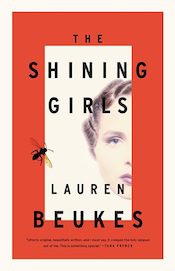
As I read The Shining Girls by Lauren Beukes, every photographer at the Chicago Sun-Times was fired. An entire era had come to an end. I live in Chicago and watched a news piece where the photographers had come to commiserate at the legendary journalist’s hangout Billy Goat. (You might know it from the old Saturday Night Live skit with John Belushi, “Hamburger! Hamburger! Hamburger!”) Some of the major characters in The Shining Girls at the Chicago Sun-Times and hang out at Billy Goat. Their temporal reality is 1992-1993, twenty years away from the much-heralded “death of print.”
Eras end, and time is revealed not as a stream but pockets, little frozen dimensions we can access without linearity. Beukes, who gained recognition for the literary science-fiction noir Zoo City, is a South African writer fostering the gradual recognition that science fiction and literary fiction can be at least neighbors if not actual housemates. The Shining Girls offers the reader a time-traveling serial killer stalking his victims through Chicago from the Great Depression to the early 90s. Via the properties of a mysterious house which seemingly exists outside of time, Harper Curtis, the novel’s antagonist, is able to pass between eras freely.
This paranormal ability allows Beukes the necessary trope to explore the history of Chicago and the history of the American twentieth century writ large. Harper’s victims are reflective of their times without being stereotypes. He stalks history as much as individual women. Don’t take this the wrong way. His victims are living, breathing characters that Beukes is able to make you sympathize with and care about in the scant few pages of introduction before each are slain. This is no small feat to be sure.
Where Harper is the driving force in the novel, Kirby Mazrachi, daughter of a free-spirited and frequently stoned single mother, is the counterpoint to his machinations. She is, in fact, the only victim of his to survive. In a grueling and touching scene, we see just how it was that Kirby managed to survive the savage stabbing. Now, she carries the scars of that day both literally and figuratively, focusing her complex and tormented feelings toward finding her would-be killer.
Her unlikely ally is one Dan Velasquez, former homicide reporter for the Chicago Sun-Times. Dan, too, has been close enough to murder to have soured on the human condition. He spent years tracking the details of victims and cases, eventually burning out and becoming a baseball reporter. Kirby becomes his rebellious intern. While doing her duty in tracking daily batting averages and rumors of impending trades, she is secretly compiling a collage-like case file of other victims she believes may have been killed by the man who tried to murder her.
In broad strokes, The Shining Girls plays like a taut psychological thriller. There is the victim who needs to resolve her near death, the killer whose motives are clouded in the insanity and cruelty which comprise his being, and the inevitable confrontation between them. But Beukes’ novel is less about murder and thrills than it is about time. Like Harper, who literally cuts his way through the shifting zeitgeist of American history, the narrative toggles between years as one might change channels on a TV. In short, emotionally powerful chapters, Beukes takes us from Hooverville Depression era shanty towns, Radium laced sex shows and on to the early 90s punk scene.

Her narrative structure rejects the linear shape consumers of narrative have long taken as mandatory. Instead, she takes sixty years of history and goes after them with the Burroughs cut-up technique. Burroughs once opined that, “When you cut into the present, the future leaks out.” It’s a vision realized Beukes who, while ostensibly writing a thriller, owes as much to William S. Burroughs, Philip K Dick and Haruki Murakami as she does to Tana French, Dennis Lehane or the true crime stores of the old pulp magazines. Where most stories eventually resemble a line of chronological events, no matter how fractured, The Shining Girls is constructed like a loop.
Much like her narrative, Beukes picks and chooses from the pop cultural super-market, taking what she needs, tossing what she doesn’t. You can’t classify this as a thriller or science fiction — though publicists and retailers no doubt must. It is instead its own hybrid — a story which dissects our post-modern sense of time as much as it deconstructs the idea that crime novels give a reader an sense of cause and effect. Mysteries occur and are solved in most crime fiction. This novel suggests reasons are our own inventions.
Both killer and victim, Harper and Kirby, are attempting to make sense of the seemingly unrelated episodes of their life. They are trying to craft a narrative from the fragmented shards of their shared histories. Beukes makes this very clear when, in 1987, Harper stumbles upon a school science fair. There, he sees a student’s map of the constellations and realizes, “There is only one name left. He does not know what will happen after. But he has to do it properly. The way he is supposed to. He has to set things right, align the constellations.” Or, as Beukes writes about Kirby, “She flips ahead — the photographs aren’t in any kind of chronological order….” Therein lies the book’s central premise. Time is a collection of moments we bind up in albums to make stories. Time itself has no story, no order. Both Harper and Kirby move throughout the story trying to make sense of their lives. Harper finds the mysterious, time-unstuck house, and is compelled to seek and kill girls who “Shine.” There is no clear reason why the house wants him to do this, nor what he will get for it in the end. He is making his own constellations. He is blinking from one moment in history to another trying to construct a giant mural of death that could only possibly make sense to a culture that’s left linear time behind.
This is why it’s so important that Beukes’ story never cross the year 1993. She’s established a Rubicon for herself, the time before the Internet, ubiquitous computing and the seemingly infinite, contextless now. Her story doesn’t work as well in a world where the characters have access to Google, to the seemingly infinite cyberspace of human detail at our fingertips. People still use pays phones and pagers in her world. There’s no dialing someone on their cell in an emergency. The year 1993, just twenty years ago, is already a historical curiosity.
While the central framing time of the novel may be in the recent past, Kirby and Harper are very much creatures of our time. Their lives, whether by their own choice or that of fate, have become shredded calendars. Their time is elastic. Beukes relentlessly jump cuts through the timeline like an ontologically motivated Michael Bay. We see Kirby as a child just after a chapter in which we know her as an adult. We know she will become an attempted murder victim before she does. Her life, her story, is cut-up metaphorically by the very real knife Harper uses on his victims.
It’s a satisfying story for a fragmented, disordered era. The punk music Kirby listens to back in the early 90s, music she must seek out in underground clubs and ‘zines, is accessed by us with the same ease of iTunes. The stats and rumors Dan Velazquez pursues as his career are now automated things we can find on our phones any time we wish. The era pre-dating ubiquitous information and elastic time is over. It ended when the analogue age came to a close, and the digital age began. Killer and victim are both bound up in the prescient realization that time and history are becoming merely ways of talking about something abstract rather than passing through something concrete. In the end they fail to make sense of time or self. There are no constellations, for they are nothing but the product of human pattern recognition. We map pictures on the stars which are not there. Like the characters in the book, our histories have been cut up, and all times are leaking out. The future and past commingle inextricably with the present. Everything is happening now.




